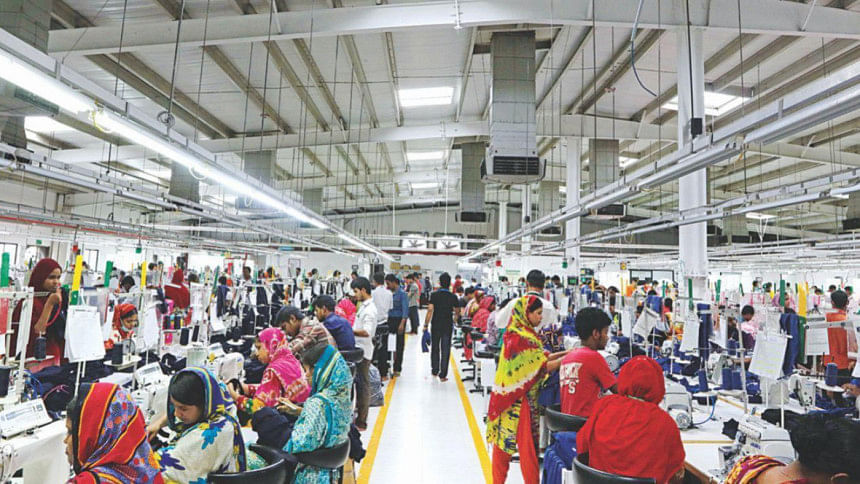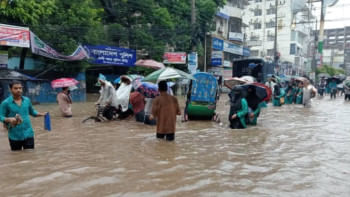Up in the clouds

Your columnist has just completed a little over a month of being a "female" leader of an exporters' association. A number of congratulatory messages have flowed in, the bouquets have flooded our living room, and then there were the telephone calls and texts, the social media felicitations… they have all been wonderful. Victory, I assumed, was going to be a humbling experience. It has, in turn, turned out to be an overwhelming one. The reference to me being a "female" was a hiccup. I had also earlier thought that being an exporter was good enough; it now seems that being a female makes it quite different. Your columnist is apparently the "first" female president of the said organisation. That label made me think harder. Leading a sector where 80 percent of workers are women seemed the most natural thing on my part. Yet it isn't.
It really isn't, because (1) there are 22 factories that faced closure in the last one month; (2) export growth has been only 5.70 percent in the last five years, compared to 17.82 percent in the 2003-2013 period; (3) prices have fallen in the USA by 5 percent and in Europe by 4 percent; (4) wages have gone up by 184 percent in the last five years; (5) productivity has stayed at 40 percent as a national average; (6) we have extra capacity and are engaged in unfair competition against one another by accepting any price from any buyer; (7) the narrative and global perception around our labour issues have remained negative; and (8) there is an image deficit hovering around the sector in the form of an unholy halo.
Yet, there are 3.5 million men and women working in this sector, which contributes 82 percent of the economy and pays around Tk 27,500 crores to our workers as salary. Thus, at this point of time, a few facts have become necessary for a reality check. Sharing only a few with you below:
Small is beautiful
Compared to the big factories, the small and medium ones contribute around 40 percent to the export basket. Times have changed. Small industries are becoming more viable, especially because consumer tastes have changed and shoppers buy more online.
Smarter, faster, blockchain-enabled Artificial Intelligence is encouraging the world to shop online.
Current trends predict that 51 percent of Americans prefer online shopping, with e-commerce growing at 23 percent year-over-year. With that trend almost setting in, the order quantities are smaller and the huge factories that most of us have constructed aren't equipped to handle smaller quantities. Small doesn't make sense to many of us as we focus on optimising our efficiency with repetitive production processes. Yet, the demand for small fashion quantities with more styles and shorter lead time has begun to surface.
Change in consumer pattern
Consumers today don't prioritise quantities, and stress more on quality, especially because in a world of cramped spaces, their closet sizes have shrunk along with their pockets. Does that mean that people will be buying fewer clothes? Probably. Does that mean that consumers will look for value-added products? Probably. Thus, the most logical inference will be that quantities will go down while qualities will soar. In a probable scenario such as this, we will need smaller, specialised, compliant units to produce the fashion orders. How will the bigger units react? Will they be able to accommodate smaller quantities in their humungous capacities? Will they be able to do multi-products, multi-styles? We will all need to readjust our needle to fit the global demand. A 100-line factory will then probably need to split its lines up to cater to at least 30 styles instead of the five styles that it is used to produce.
Subsiding crucial sectors
Current incentives to all sectors have been generous. The government is providing subsidies up to 20 percent in agriculture, which has, in the last 10 years, reported a growth of USD 445 million; subsidy has been up to 7-10 percent to shrimp, which has had only USD 34 million growth; 2-5 percent for frozen fish, which has reported a dip to USD 58.30 million from USD 80.51 million; 10 percent subsidy to plastic, reporting growth of USD 46 million; 10 percent to pharmaceuticals with growth of only USD 67 million; 10 percent to ceramics, reporting a growth of USD 21 million; 15 percent to leather and furniture which reported an increase of USD 962 million. Just an incentive of 4 percent to the ready-made garment (RMG) sector for new markets has alone fetched USD 3.8 billion.
Generous gestures
India has offered 500 crore rupees as Technology Upgradation Fund for the garment manufacturers, and provided 5 percent extra Duty Drawback amounting to 5500.00 crore rupees. India is bearing 12 percent provident fund of the workers, which was earlier borne by the factories. India is also providing 3 percent subsidy on bank interests for five years for exporters with effect from April 1, 2019. On top of that, India also provides 10-20 percent subsidy on capital machinery and spare parts.
Vietnam offers its exporters zero tax for the first four years, then 50 percent for the next nine years, and then 10 percent for the next 15. Exporters are also exempted from VAT and enjoying tax-free access to capital machinery, along with being given special incentives to garment export, especially when the industrial units host 500-5000 workers. Vietnamese entrepreneurs also receive 50 percent subsidy on production costs in the trial phase. Vietnam also offers low interest credit facility for entrepreneurs who invest in green factories and provide funds from Vietnam Environment Protection Fund. Exporters also enjoy a rent-free privilege for seven years in case of an investment in readymade garment and textile.
Pakistan gives exporters 4 percent duty drawback and also gives an additional 2 percent for new markets. Pakistan, under its export refinancing scheme, has also reduced the rate of interest from 9.4 percent to 7.5 percent while also giving duty-free advantage to import capital machinery. In case of new machinery, Pakistan is giving 15 percent subsidy. In case of value-added industries, exporters are receiving loans at 9 percent interest rate for a 3-10 year period as Long Term Financing Facility. Fast track channels have been introduced in Pakistan to initiate quick settlement of exporters' dues.
While I race towards the end of the column, we are close to three hours away from Tokyo, where Bangladesh prime minister is leading 53 of us in her business delegation. Beginning from the 1973 visit of Bangabandhu to Japan, and the striking similarities between the flags of Japan and Bangladesh, we have come a long way. Our annual export to Japan has crossed USD 1 billion since 2015-16 and we have also recorded a growth of 11.73 percent during the last fiscal year. Japan, as the seventh largest export destination, and Bangladesh have bilateral trade crossing the USD 3 billion mark. Export to Japan has increased 6.5 times between 2008 and 2018. This is a sign of a clear recovery from the 2016 setback.
Since 2007, apparel export has expanded more than 35 times. But the challenge has been in the value addition part. In 2018, our 5.6 percent apparel export to Japan resulted in only 3.9 percent in value in the import market. In general, the number of Japanese companies has risen to 280 as of December 2018. A 2018 Jetro survey ranked Bangladesh as the highest in terms of future expansion plan in the next 1-2 years. In brief, in order to facilitate trade between Bangladesh and Japan, challenges in active facilitation measures including infrastructural problems, hurdles in the tax regime, hiccups in port handling and so on must be addressed.
Well, as they say, opportunities and challenges are like an inseparable duo.
Dr Rubana Huq is the President of BGMEA and the Managing Director of Mohammadi Group. Her Twitter handle is @Rubanah.
Follow The Daily Star Opinion on Facebook for the latest opinions, commentaries and analyses by experts and professionals.
To contribute your article or letter to The Daily Star Opinion, see our guidelines for submission.

 For all latest news, follow The Daily Star's Google News channel.
For all latest news, follow The Daily Star's Google News channel. 



Comments